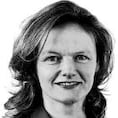Novelist Salman Rushdie tells a good story about one of his successes in his 10-year career as a copywriter in London.
With an afternoon client presentation looming – for Aero chocolate bar – a colleague working on the account in the Ogilvy & Mather creative department still hadn’t come up with anything.
With just hours to go, he called on Rushdie for help, saying in a panic-fuelled stammer “It’s f******g impossib-ib-ib-ible”. For Rushdie it was, he has said, “my one genuine light-bulb moment”; bubbles are Aero’s USP and he quickly jotted down every word he could think of ending in “ible” or “able”.
His many subsequent one liners, which included “Adorabubble” and “Delectabubble, went on to be one of the best remembered and long running campaigns for the brand.
Creative departments are all about collaboration – planned and tightly mapped or simply accidental due to proximity. It’s not a dynamic that naturally transfers to working from home.
While other areas in advertising, such as administration, strategy, even client services (when the clients are also at home) don’t absolutely require people to be in the same room to get the job done – and hence were affected in the same way as other cubicle-bound office jobs when working from home kicked in in March 2020, for creative departments it’s been a challenge – though one where Irish agencies nevertheless have managed to produce top-notch work.
Projects
“Large creative projects or collaborations are so much easier in the office. [Working from home] You miss all the quick, osmosis like, soft skill, people check-in’s that just happen. Screen fatigue. Lack of collegiate atmosphere. It can drain the cultural reservoir of a place,” says Pat Stephenson, founder and chief relationship officer of Dublin agency Boys and Girls, who mentions plans to return to the office in September, “at the latest”.
“Currently the office is open on a very limited basis. Lots of our staff were struggling in home environments so we have a limited pre-booked, Covid compliant office set-up,” he says, adding that the back-to-office plan won’t be one-size fits all.
“The plan is to look at how to allow people to enjoy the best of home (deep work, flexibility) and office, (culture plus collaboration plus creativity).”
The agency was one the first to make a TV ad for a major client in the first lockdown. Its “Monster” ad for Three mobile, with the little boy talking to his granddad on an iPad worried there was a monster, quite brilliantly worked around the then very tight Covid restrictions on filming, using iPhones for filming and remote directing.
As with other agencies, new business pitches continued with Boys and Girls bagging, among others, Chelsea FC and Lego Experiential. “Actually it’s been a difficult but better year than anticipated when we shut down in March-April [2020],” says Stephenson.
It’s the same story at Publicis which still managed workarounds to shoot major campaigns for clients including Virgin Media, Vhi, Heineken, and Ptsb remotely, in Ireland, Ukraine and South Africa. “Heads together is a bit more difficult. Workshops aren’t as good on teams,” says Jimmy Murphy, director of the agency, of pandemic working.
“We use Mural and Zoom which are good tools but hard to keep the energy going for a sustained period. Creatives can work surprisingly well as two- or three-person teams but we do miss the buzz of a big creative department, in the same space, bouncing off each other.”
Public health guidelines permitting, September is earmarked for staff to move back to the Publicis office, with a hybrid solution typical of all office-centred companies, of three days in, two at home: “There will be set days [for people]. It means less of those awful hybrid meetings; half-live, half-Zoom,” says Murphy.
At Rothco/Accenture Interactive, there’s no firm date for the move back to its spacious “specifically designed to foster collaboration” offices in Smithfield with Richard Carr chief executive, Rothco, managing director Accenture Interactive UK, echoing his peers with a strategic, thoughtful approach to bringing staff back in from their home offices.
Opportunity
“We want to be collaborative, flexible and offer our people the opportunity to work in way that works with their individual needs and roles – while balancing the needs of our clients.” Of the bigger staffing picture, he says, “Flexibility is important in attracting and retaining the very best talent.”
“We want to make sure everyone is safe and thrives whether they are physically in the workplace or not.”
At Rothco, the business of creating campaigns continued, ranging from summer and winter campaigns for Woodies (the one with the young lad helping the elderly lady by fixing her gate is destined to become an Irish adland Christmas classic, in the mode of the Barry’s Tea “Trainset”) to extensive work for AIB among many others on the long client list.
Carr is particularly proud of one “truly creative global campaign, all created from the living rooms and kitchen tables of Ireland. [For] Saylists we teamed up with Warner Music to create playlists launched on Apple Music, aimed at augmenting the speech therapy experience for young people through the power of music and technology”.
Agencies have proved they can work effectively and creatively remotely though there is a sense that despite the measured talk and careful planning of hybrid work models, it’s an industry that just wants to back in the room – and to meet clients face-to-face there. “As humans we are hardwired to be in physical proximity, we are drawn to groups and tribes,” says Carr. “It actually makes us happier.”
As to how the transition from working from home will all work out after the challenges of the pandemic and the impact of the radical changes in work practice it brought: “I think it’s a great opportunity to reimagine work. Nobody can say, ‘well that will never work’,” says Murphy.















